Once, a fitter told a lady who was not very knowledgeable in electrical engineering the reason for the loss of light in her apartment. It turned out to be a short circuit, and the woman demanded that it be lengthened immediately. You can laugh at this story, but it’s better to consider this trouble in more detail. Electrical specialists, even without this article, know what this phenomenon is, what it threatens and how to calculate the short circuit current. The information below is addressed to people who do not have a technical education, but, like everyone else, are not immune from the troubles associated with the operation of equipment, machines, production equipment and the most common household appliances. It is important for every person to know what a short circuit is, what are its causes, possible consequences and methods to prevent it. You can not do in this description without getting acquainted with the basics of electrical science. A reader who does not know them may get bored and not finish reading the article to the end.
Here is this formula, which says that the voltage at the terminals of an electric dipole is equal to the product of the resistance of this dipole and the current that passes through this dipole. It should be added that this formula is applicable only for devices in which electricity is converted into heat. Ohm's law does not apply to a motor.
Influence of the ohm law in an electrical installation: isolation and short circuit
Is Ohm's Law Helpful?
A little math, isolation and short circuit explanation. By doing a little math with Ohm's law formula, we can explain two phenomena: isolation and short circuit. When two electrical circuits are not physically connected, these circuits are said to be insulated: the resistance between these two circuits is therefore infinite: in fact, using Ohm's law and the infinite value of resistance, we see that the final current is zero: we are then talking about isolation electrical circuit. Zero, the final current will theoretically be infinite: we are talking about short circuit. In practice, when two live wires are brought into contact, there is very little resistance between the two. That is why in some cases there is a strong release of energy, a spark or an explosion. This third part is dedicated to control electrical installations, will be processed in three separate parts.Popular exposition of Ohm's law
No matter what the nature of the current in an electrical circuit is, it only occurs if there is a potential difference (or voltage, it's the same thing). The nature of this phenomenon can be explained by the example of a waterfall: if there is a level difference, the water flows in some direction, and when not, it stands still. Even schoolchildren know Ohm's law, according to which the current is the greater, the higher the voltage, and the less, the higher the resistance included in the load:
Short circuit current measurement
The purpose of this measure is thrice. First, to ensure that protection is guaranteed if none of the other two recognized methods are protected - omitting contact voltage up to 50 volts or reducing the contact current to a maximum value of 0.5 mA. Secondly, make sure that the insulation of the conductors used does not get too hot in the event of a short circuit. The third goal is to ensure that the overcurrent torch is built to be able to reduce the short circuit current, even if it is very important.
I is the magnitude of the current, which is sometimes called "current strength", although this is not a completely competent translation from German. It is measured in Amperes (A).
In fact, the current itself does not have power (that is, the cause of acceleration), which is exactly what manifests itself during a short circuit. This term has already become familiar and is often used, although teachers of some universities, having heard the words “current strength” from the lips of a student, immediately put “bad”. “But what about the fire and smoke coming from the wiring during a short circuit? - the stubborn opponent will ask, - Is this not strength? There is an answer to this comment. The fact is that ideal conductors do not exist, and their heating is due precisely to this fact. If we assume that R=0, then no heat would be released, as is clear from the Joule-Lenz law below.
The role of the protective conductor
In the event of a short circuit, it is not uncommon for the current to flow primarily through the polar conductor and the protective conductor connected to the conductive sheath of the device. Without protective conductor the device will be permanently set to 230 V, which may present a great risk of electric shock to any person who comes into contact at the same time with the device and any element installed at ground potential. When connecting a protective conductor to the device, the voltage is divided by two. This leads to a decrease in the fault voltage.
U is the same potential difference, also called voltage. It is measured in Volts (we have V, abroad V). He is also called electromotive force(EMF).
R- electrical resistance, that is, the ability of a material to prevent the passage of current. For dielectrics (insulators) it is large, although not infinite, for conductors it is small. It is measured in ohms, but is estimated as a specific value. It goes without saying that the thicker the wire, the better it conducts current, and the longer it is, the worse it is. Therefore, resistivity is measured in ohms multiplied by square millimeter and divided by the metre. In addition, its value is affected by temperature, the higher it is, the more resistance. For example, a gold conductor 1 meter long and 1 sq. mm at 20 degrees Celsius has a total resistance of 0.024 Ohm.
Goal 1: protection of individuals
This results in an increase in the fault voltage. Other factors, such as the section or length of the line through which the fault current flows, will change this fault voltage. It usually ranges from 80 to 115 volts. A fault voltage with a value equal to or greater than 80 volts is dangerous, a person touching the device may have a current that prevents self-excitation, as well as the risk of cardiac fibrillation. Therefore, it is necessary to limit the time required to close the plant.
The table below shows that the incision in this case must occur within 400 ms if any fatal risk of cardiac fibrillation is to be avoided. All terminal circuits up to 32 A must turn on within 0.4 seconds. Other circuits should be no more than 5 seconds.
There is also Ohm's law formula for complete chain, the internal (intrinsic) resistance of the voltage source (EMF) is introduced into it.
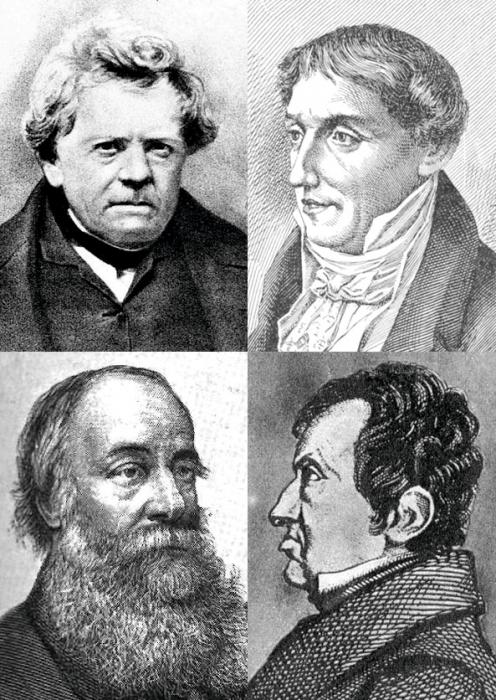
Two simple but important formulas
It is impossible to understand the reason why a short circuit current occurs without mastering another simple formula. The power consumed by the load is equal (excluding reactive components, but about them later) to the product of current and voltage.
Goal 2: Protection of pipelines
During a short circuit, the current rises to an ideally very high value and creates an increase in the temperature of the conductor, which, on contact, heats its insulator. The temperature increase does not occur immediately, and in a short time the heat exchanges between the pipes and the surrounding air are negligible. Therefore, there is no need to consider application methods in this dimension. Each insulation has a temperature limit for continuous use, the temperature must not be exceeded, and the absolute temperature limit must not be exceeded, under the threat of not being able to guarantee the quality of the insulation for 20-50 years that the object must operate.
P - power, Watt or Volt-Amp;
U - voltage, Volt;
I - current, Ampere.
Power is never infinite, it is always limited by something, therefore, with its fixed value, as the current increases, the voltage decreases. The dependence of these two parameters of the working circuit, expressed graphically, is called the current-voltage characteristic.
However, contrary to what is often heard, there is no doubt that the insulation will ignite if these limits are slightly exceeded. To find out how long it takes for a pipeline to reach its limit temperature according to the short circuit current flowing through it, use the following formula. Note: This formula is only applicable for very short periods of time.
This formula is valid for all short circuit currents, however in control only the interest in the smallest short circuit current is interesting because it causes the shortest response time. Despite this, measurements are usually taken at the end stationary installations rather than downstream mobile cables.
And one more formula necessary in order to calculate the short circuit currents is the Joule-Lenz law. It gives an idea of how much heat is generated when resisting a load, and is very simple. The conductor will heat up with an intensity proportional to the magnitude of the voltage and the square of the current. And, of course, the formula is not complete without time, the longer the resistance is heated, the more heat it will release.
After measurement, it is ensured that the prospective short-circuit current is less than the breaking capacity of the circuit breaker or fuses. In practice, this current is very rarely too high in small installations. A certain habit of setting allows some controllers to refrain from this measure in this situation, because the breaking capacities of circuit breakers - often 10 or 16 kA at present - or fuses - 50 to 150 kA - are very large more than the short-circuit currents at the end of the collector line.
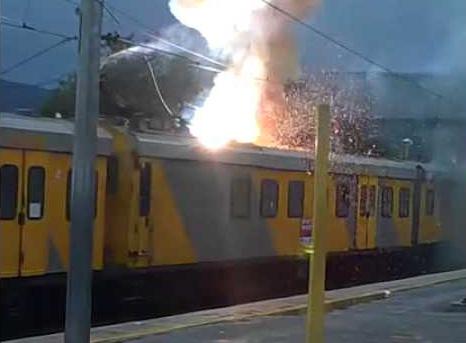
What happens in the circuit during a short circuit
So, the reader can consider that he has mastered all the main physical laws in order to figure out what the magnitude (okay, let it be) of the short circuit current can be. But first you need to decide on the question of what, in fact, it is. A short circuit (short circuit) is a situation in which the load resistance is close to zero. We look at the formula of Ohm's law. If we consider its version for a section of the circuit, it is easy to understand that the current will tend to infinity. In the full version, it will be limited by the resistance of the EMF source. In any case, the short-circuit current is very large, and according to the Joule-Lenz law, the larger it is, the more the conductor along which it goes is heated. Moreover, the dependence is not direct, but quadratic, that is, if I increases a hundredfold, then ten thousand times more heat will be released. This is the danger of a phenomenon that sometimes leads to fires.
A short circuit is an electrical phenomenon that occurs especially when two electrical wires come into direct contact, most often as a result of insulation failure. This results in a sudden increase in current intensity, which may increase.
Short circuit: when the current takes the label
A bit of theory: there are always at least 2 wires in an electrical installation. Electricity enters one and leaves the other. Between them it passes through electrical appliance and makes it work. When insulating plastic material damaged, two wires can touch directly without passing through the device. The current then takes a shortcut, hence the name short circuit.
The wires glow red hot (or white hot), they transfer this energy to walls, ceilings and other objects that they touch and set them on fire. If the phase in some device touches the neutral conductor, a short-circuit current of the source occurs, closed to itself. The combustible base of electrical wiring is a nightmare for fire inspectors and the cause of many fines imposed on irresponsible owners of buildings and premises. And the fault, of course, is not the laws of Joule-Lenz and Ohm, but the insulation dried up from old age, carelessly or illiterate installation, mechanical damage or overloading of the wiring.
Short circuit = risk of fire
When a current passes through the apparatus, the latter opposes it with resistance, like a barrier opposing the resistance to the passage of the water of a river. Therefore, the current flows with little flux. We are talking about low intensity. In the event of a short circuit, it is as if a dam has broken: the current flows freely, without resistance, like a raging river. The intensity is enormous and causes the wire to heat up. So much so that the insulation material can melt and catch fire, which can cause a fire in the building.
To avoid short circuit, each power line is equipped with one. This little device detects abnormally high current, and in this situation it reduces the current on the line. The general circuit breaker also protects the installation head and can cut current throughout the house at the same time.
However, the short-circuit current, no matter how large, is also not infinite. The size of the troubles that he can do is affected by the duration of heating and the parameters of the power supply scheme.
AC circuits
The situations discussed above were of a general nature or concerned DC circuits. In most cases, both residential and industrial facilities are supplied with electricity from the network. AC voltage 220 or 380 volts. Trouble with DC wiring most often occurs in cars.
This allows excess current to be freely discharged to ground. This method can be used when the characteristics of the power supply are unknown. The upflow momentum of the considered circuit is calculated from the estimate of the short circuit current at its beginning.
After a short circuit occurs on the terminals synchronous generator the fault current decreases according to three time scales corresponding to three currents. Thus, with impedance values in a reduced unit and the nominal intensity of the generator. Thus, at the terminals induction motor the short circuit current is equal to the initial current. In the event of a mains failure, its contribution to the failure current will depend on the distance of the failure.
There is a difference between these two main types of power supply, and a significant one. The point is that the passage alternating current prevent additional components of resistance, called reactive and due to the wave nature of the phenomena arising in them. Inductances and capacitances react to alternating current. The short circuit current of the transformer is limited not only by active (or ohmic, that is, one that can be measured with a pocket tester) resistance, but also by its inductive component. The second type of load is capacitive. Relative to the active current vector, the vectors of the reactive components are rejected. The inductive current lags behind, and the capacitive current leads it by 90 degrees.
Formulas for calculating the short circuit current
Many software packages have been developed to calculate short circuit currents in accordance with standards. The most advanced can take into account the dynamic aspect of the short circuit and can also run simulations. AT three-phase network for remote failure of rotating machines direct currents short circuit can be calculated using.
Jargon for power system operators
![]()
This value is part of the important data exchanged between.
Transformers in dry and oil
Oil transformers are inside a metal container containing mineral oil, which has a dual function. Insulation between windings and ground.An example of the difference in the behavior of a load that has a reactive component is a conventional speaker. Some lovers of loud music overload it until the magnetic field knocks the diffuser forward. The coil flies off the core and immediately burns out, because the inductive component of its voltage decreases.
To remove heat produced by copper, Joule effect and iron for hysteresis and parasitic currents. They are often provided with an oil preservative, an enlarged cylindrical vessel with a capacity of about a tenth of the capacity, so that the liquid can flow out as the temperature rises. The silica gel filter allows the consistorist to contact the outside air, preventing moisture from entering the dielectric hardness of the oil. However, the filter must be replaced periodically.
An alternative solution is to pressurize the hull by inserting a dry air or nitrogen blanket on top, which allows the liquid to expand without deforming the hull. Dry transformers can be in the air or have resin windings built in. They don't require Maintenance in practice, and they are definitely preferable in environments where the risk of fire is high.
Types of short circuit
Short circuit current can occur in different circuits connected to different sources of direct or alternating current. The easiest way is with the usual plus, which suddenly connected with the minus, bypassing the payload.
But with alternating current, there are more options. Single phase current a short circuit occurs when a phase is connected to a neutral or grounded. In a three-phase network, unwanted contact between two phases may occur. A voltage of 380 or more (when transmitting power to long distances on power lines) volt can also cause unpleasant consequences, including an arc flash at the time of switching. It can close all three (or four, together with the neutral) wires at the same time, and the three-phase short circuit current will flow through them until the protective automatics work.
Oil-filled transformers achieve more power, but are more bulky and require higher installation and maintenance costs. The manufacturer installs a metal plate with basic nominal dimensions. Power, primary voltage, secondary voltage, primary current, secondary current, short circuit voltage, windings and cluster connections. In addition, the insulation level is indicated: for the primary, test voltage at an industrial frequency of 50 kV and with an atmospheric pulse of 125 kV, and for the secondary, only a test voltage at an industrial frequency of 8 kV.
But that's not all. In rotors and stators electrical machines(motors and generators) and transformers, sometimes such an unpleasant phenomenon as an inter-turn short circuit occurs, in which adjacent wire loops form a kind of ring. This closed loop has extremely low AC resistance. The strength of the short circuit current in the turns increases, this causes the entire machine to heat up. Actually, if such a disaster occurs, you should not wait until all the insulation melts and the electric motor smokes. The windings of the machine need to be rewound, this requires special equipment. The same applies to those cases when, due to the “interturn”, a short-circuit current of the transformer has arisen. The less the insulation burns, the easier and cheaper rewinding will be.
Short circuit current calculation
No matter how catastrophic this or that phenomenon, its quantitative assessment is important for engineering and applied science. The short circuit current formula is very similar to Ohm's law, it just needs some explanation. So:
I short circuit = Uph / (Zn + Zt),
I k.z. - value of short circuit current, A;
Uph- phase voltage, AT;
Zn is the total (including the reactive component) resistance of the short-circuited loop;
Zt is the total (including the reactive component) resistance of the power transformer (power), Ohm.
Impedances are defined as the hypotenuse of a right triangle, the legs of which are the values of active and reactive (inductive) resistance. It's very simple, you need to use the Pythagorean theorem.
Somewhat more often than the short-circuit current formula, experimentally derived curves are used in practice. They represent dependences of the value of I k.z. on the length of the conductor, the cross section of the wire and the power power transformer. Charts are a collection of descending exponential lines, from which it remains only to choose the appropriate one. The method gives approximate results, but its accuracy is well suited to the practical needs of power supply engineers.
How is the process
Everything seems to happen instantly. Something hummed, the light dimmed and immediately went out. In fact, like any physical phenomenon, the process can be mentally stretched, slowed down, analyzed and divided into phases. Before the onset of the emergency moment, the circuit is characterized by a steady current value that is within the nominal mode. Suddenly, the impedance drops sharply to a value close to zero. The inductive components (electric motors, chokes and transformers) of the load at the same time, as it were, slow down the process of current growth. Thus, in the first microseconds (up to 0.01 sec), the short-circuit current of the voltage source remains practically unchanged and even slightly decreases due to the onset of the transient. At the same time, its EMF gradually reaches zero, then passes through it and is set at some stabilized value, which ensures the flow of a large I short circuit. The current itself at the time of the transient process is the sum of the periodic and aperiodic components. The shape of the process graph is analyzed, as a result of which it is possible to determine constant value time, depending on the angle of inclination of the tangent to the acceleration curve at the point of its inflection (first derivative) and the delay time, determined by the value of the reactive (inductive) component of the total resistance.
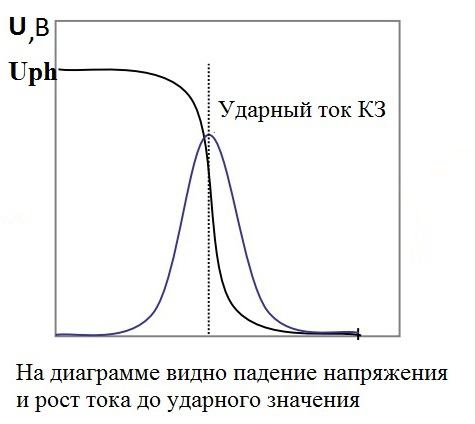
Surge short-circuit current
In the technical literature, the term "short-circuit shock current" is often found. You should not be afraid of this concept, it is not at all so terrible and has nothing to do with electric shock. This concept means the maximum value of I k.z. in the alternating current circuit, which usually reaches its value in half a period after the emergency situation has arisen. At a frequency of 50 Hz, the period is 0.2 seconds, and its half is 0.1 seconds, respectively. At this moment, the interaction of conductors located close to each other reaches its maximum intensity. The shock short-circuit current is determined by the formula, which in this article, intended not for specialists and not even for students, does not make sense. It is available in specialized literature and textbooks. In itself, this mathematical expression is not particularly difficult, but it requires rather voluminous comments that deepen the reader into the theory of electrical circuits.

Useful short circuit
It would seem that the obvious fact is that a short circuit is an extremely bad, unpleasant and undesirable phenomenon. It can lead, at best, to a de-energization of the facility, shutdown of emergency protective equipment, and, at worst, to burnout of the wiring and even a fire. Therefore, all efforts must be focused on avoiding this scourge. However, the calculation of short-circuit currents has a very real and practical meaning. A lot of technical means have been invented that operate in the mode of high current values. An example is the usual welding machine, especially arc, which at the time of operation almost short-circuits the electrode with grounding. Another issue is that these regimes are of a short-term nature, and the power of the transformer makes it possible to withstand these overloads. When welding at the point of contact of the end of the electrode, huge currents pass (they are measured in tens of amperes), as a result of which enough heat is released to locally melt the metal and create a strong seam.
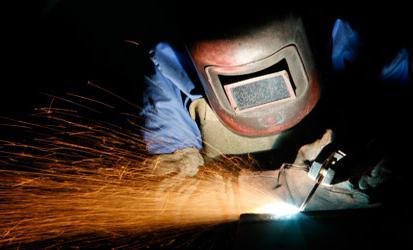
Protection methods
In the very first years of the rapid development of electrical engineering, when humanity was still boldly experimenting, introducing galvanic devices, inventing different kinds generators, motors and lighting, the problem arose of protecting these devices from overloads and short circuit currents. Its simplest solution was to install fusible elements in series with the load, which were destroyed by resistive heat if the current exceeded the set value. Such fuses serve people today, their main advantages are simplicity, reliability and low cost. But they also have disadvantages. The very simplicity of the “cork” (as the holders of fusible rates were called for their specific shape) provokes users, after its burnout, not to philosophize slyly, but to replace the failed elements with the first wires, paper clips, and even nails that come to hand. Is it worth mentioning that such protection against short-circuit currents does not fulfill its noble function?
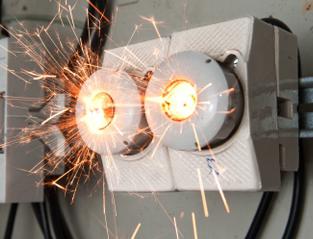
In industrial plants for de-energizing overloaded circuits circuit breakers began to be used earlier than in apartment shields, but in recent decades, "plugs" have been largely replaced by them. "Automatic machines" are much more convenient, they can not be changed, but turned on by eliminating the cause of the short circuit and waiting for the thermal elements to cool down. Their contacts sometimes burn out, in which case it is better to replace them and not try to clean or repair them. More complex differential automata at a high cost do not last longer than usual ones, but functionally their load is wider, they turn off the voltage in case of minimal current leakage “to the side”, for example, when a person is struck by an electric current.
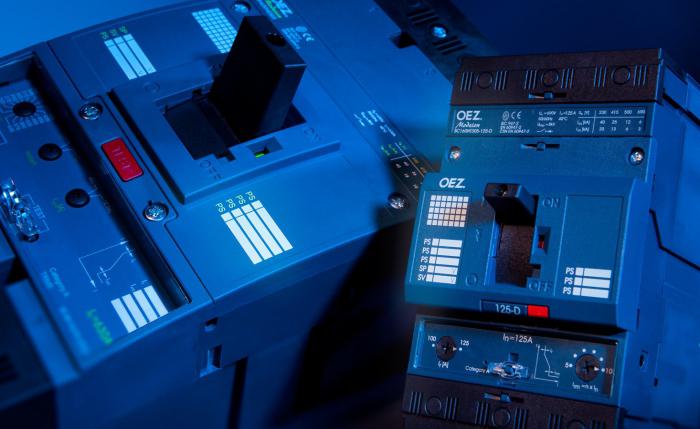
In everyday life, experimenting with a short circuit is not recommended.
Page 1
| Dependence of three-phase short-circuit currents on the length and cross-section of a cable with copper conductors in a 380 V network when powered by a 750 kVA transformer (IR 8%. |
The strength of the short circuit current at the motor terminals depends on the power of the supply transformer, the length and cross section of the connecting cable.
The strength of short-circuit currents is usually calculated using the no - resistance method. The essence of the method is to determine the resistance value of individual elements of the system, then the total (total) resistance of the entire network from the power supply source to the fault site, and by the magnitude of the total resistance - the short circuit current strength. In this case, the resistance of individual sections of the network with different voltages is referred to the voltage of the short circuit.
The strength of the short-circuit current that occurs in the switched section can be limited by introducing a resistance into this section, and the operating current of the rotor must pass through such a resistance only during switching. The latter is necessary in order not to have too large heat losses.
If the short circuit current exceeds 2000 A/V.
Measurement of short-circuit currents in galvanic cells with low internal resistance difficult because the connection measuring device(milliammeter or ammeter) increases the resistance of the circuit and distorts the true value of the current.
Determine the short-circuit current of the battery if, at a current of 2 A, a power of 24 W is released in the external circuit, and at a current of 5 A, a power of 30 W. Find maximum power, which can stand out in the chain.
To calculate the strength of the short circuit current in networks with voltages above 1000 V, it is necessary to know the resistances of generators, transformers, transmission lines and other elements.
To limit the strength of the short circuit current that occurs when an arc is formed between the electrodes in the electrostatic precipitator, and to extinguish the arc in the circuit primary winding high-voltage transformer connected in series buffer resistance (rheostat) BS.
FROM; / - short circuit current strength, A; R - conductor resistance, Ohm; t - short circuit time, s; cpr - heat capacity of the conductor material, J / / (kg - K); mr - mass of the conductor, kg.
The values of the short circuit current calculated in this way make it possible to check the correspondence of the catalog values of the thermal (thermal) and dynamic (shock) stability of the selected devices to the calculated values of the short circuit currents.
What formula is used to determine the short circuit current.
Ijmn, close to the strength of the short circuit current, the generator does not produce more current with a further increase in the rotor speed.





